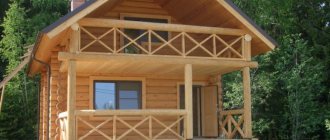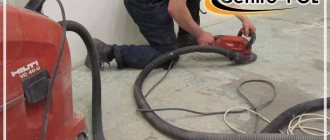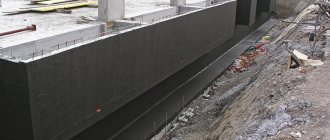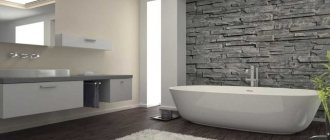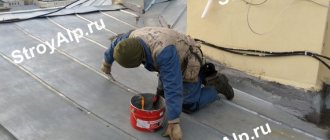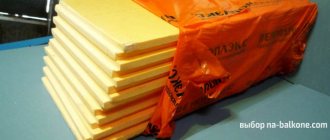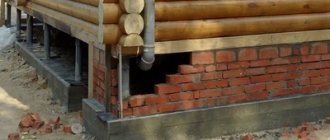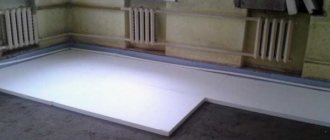One of the important stages of repair is waterproofing the balcony. Without this, any rain or snow will become a real disaster: moisture will get inside, spoil the interior decoration, promote the growth of fungi and mold, and corrosion of metal elements. That is why it is important to think in advance about protecting the balcony from moisture. Otherwise, after a few heavy rains, the balcony will be damp, and the beautiful cosmetic renovation will be irrevocably damaged.
Types of materials
There are two large types of hydraulic materials: coating and roll. Each type has its own advantages, as well as disadvantages. Thus, classic roll materials are more durable and reliable compared to coating materials. But coating materials have a much simpler application technology. So, let's look at the main materials of each of these groups.
Rolled hydraulic materials
The most common lining material is roofing felt. It is roofing cardboard impregnated with a special composition. It is installed in the usual way - using a gas burner. But there are other modern materials that are widely used in repairs to provide protection from moisture. Namely:
- Foam foil or foil-isolon. Essentially it is a porous film with a metallized coating. It is durable, does not absorb moisture, and reflects UV radiation. In addition, it provides excellent thermal insulation. So there is no need to additionally insulate the walls and floor on top of foil insulation. It is enough just to blow out the joints with foam.
- Isol. This is roofing cardboard impregnated with bitumen with various fillers: rubber, antiseptic and additives. Provides excellent vapor barrier.
- Stekloizol, hydrostekloizol. Unlike previous materials, the basis of glass insulation is fiberglass. The binding element is a special composition with bitumen and various additives. It is also additionally protected by a polymer film - one-sided or double-sided.
- Tol. This is roofing cardboard impregnated with tar products and sprinkled with mineral chips. A fairly simple and inexpensive option.
- Glass ruberoid. Unlike conventional roofing felt, bitumen in this case is applied not to roofing cardboard, but to a special glass base.
Coating hydromaterials
Coating materials are more modern, versatile and easy to use. They can be applied with a regular brush or roller. Such mixtures include various types of sealants, bitumen, cement and polymer mastics, fillers (crumb rubber, latex, plasticizer). This greatly reduces the time of waterproofing the balcony and loggia from the inside, and the resistance to external damage, moisture and other troubles of such mastics is quite high.
How to waterproof a balcony and loggia.
Waterproofing work on a balcony or loggia is a prerequisite, since precipitation can destroy the structure, and rain or snow getting inside will spoil the interior decoration. In order to eliminate the consequences of exposure to moisture in the form of fungus, mold and corrosion of metal elements and destruction of concrete, it is necessary to choose high-quality waterproofing materials that will prevent moisture from entering. Material options for waterproofing balconies.
In order to waterproof balconies and loggias, you can use coatings and rolls. Rolled materials are inferior in their characteristics and installation processes to coating materials. Let's look at how to waterproof your balcony with roll materials:
- Roofing felt is roofing cardboard that is impregnated with a special compound; it is installed using a torch.
- Foam foil or foil-isolon. Its composition is a porous film with a metallized coating and does not absorb moisture. Isol. Essentially it is roofing cardboard impregnated with bitumen with various fillers, antiseptics and plasticizing additives.
- Stekloizol, hydrostekloizol. It is fiberglass impregnated with bitumen and various additives and can have additional protection as a mineral coating. Roll materials for balconies are still relevant today, but their demand is much lower than coating materials, as they have a number of disadvantages. Bituminous waterproofing is carcinogenic, flammable, it requires special conditions during application and operation; during subsequent finishing, thick-layer mineral materials must be applied, where the use of metal mesh on vertical bases is mandatory, but it will compromise the integrity of the waterproofing layer.
Coating waterproofing
for balconies is considered a more modern option, it is universal and unpretentious, has a number of advantages and is quite easy to use and does not require special skills to apply it; you only need a brush or roller.
When using coating-type waterproofing, you will receive a high-quality waterproofing layer with high characteristics and at the same time greatly reduce the time required to carry out the work on the balcony. In addition to the fact that to provide complete protection from moisture, you need to select high-quality materials, you also need to take a responsible approach to preparing the surface of the balcony. Working with coating waterproofing GLIMS GreenResin
and
GLIMS Flex 2K
significantly saves time, because
There is no need for intermediate steps before finishing. You can apply GLIMS GreenResin either with a brush or a roller, without having any special skills. Waterproofing is applied in two layers, the intermediate drying of which will take at least two hours. Each new layer is applied after the previous layer has completely dried. Recommended temperature for application is from +5C to +35C. An indicator of the readiness of the material (drying) is the color of the waterproofing, which, when dry, changes from greenish-blue to dark green. two-component waterproofing GLIMS Flex 2K
to the prepared surface in at least two layers, with a spatula or a wide brush, the thickness of each layer is 1-2 mm, drying each layer takes at least three hours. For corners and joints, use GLIMS Corner waterproofing tape.
Each new layer must be applied perpendicular to the previous one. Construction work on the balcony can be carried out within 24 hours. The main advantage of elastic waterproofing of the coating type is that it copes well with mechanical loads due to its unique tensile characteristics, also due to its solidity and the absence of seams, which cannot be said about rolled waterproofing, and also the coating waterproofing eliminates delamination of joints and does not peel off foundations in winter. Consumption per 1 layer/2 layers, kg 0.4-0.9. Surface preparation:
Preparatory work on the balcony is carried out in a certain sequence; some believe that if there are tiles, there is no need to carry out waterproofing work, since it already has protective properties against moisture, but this is far from the case. Through the pores of the tiles and the seams between the tiles, water enters the concrete; a slight frost will be enough and the water will begin to destroy the base.
- Thoroughly clean the surface from dirt and dust, oil, paint, dirt and other substances using an industrial vacuum cleaner or a plastic brush for this purpose.
- If the base has any defects (cracks, unevenness), then they need to be repaired with the repair compound GLIMS CRT-40
,
GLIMS CRP-40 0.5 - We treat the surface with an antifungal solution - GLIMS FungiDoctor
,
GLIMS FungiPrimer
.
GLIMSFungiDocto r
is used for primary treatment , then treated with
GLIMSFungiPrimer
. The solution does not need to be diluted with anything; it is applied with a brush, roller or spray over the entire base; if the soil is quickly absorbed, then we treat it again without waiting for complete drying. For further finishing, you must wait until it dries completely (2-6 hours). - After the antiseptic has dried, prime the surface with a special primer GLIMS HydroPrimer
, thoroughly treating seams, crevices and hard-to-reach areas. It is also important to choose the right primer here, because... There are primers that are designed for highly porous and poorly absorbent substrates; they differ in their properties of the problem being solved. Deeply penetrating soils are intended to strengthen the base and create an adhesive layer, and soils for dense foundations are intended only to create an adhesive layer.
When waterproofing a balcony or loggia, you need to consider:
1. What type of balcony is open or closed 2. Where is the balcony located separately from others or next to it 3. What material is the balcony made of? If the balcony or loggia is located on the top floor and does not have glazing, then In this case, it is necessary to waterproof both the ceiling and the roof (
GLIMS GreyResin
)
Recommendations for preparatory work:
- If there are uneven bases on the balcony, they should not exceed 2 mm
- There should not be even minor sharp protrusions on the surface
- Screeds for leveling the base on the balcony should be laid in strips along the guide beacons
- Places where there is an increased risk of leaks (moving joints) must be sealed with sealing elastic tape GLIMS Corner
; in case of divergence of the structure, it stretches, and after returning to place it compresses, while maintaining the tightness of the joints. - When applying waterproofing, the humidity of the prepared base should be no more than 4%, because After you complete waterproofing your balcony, excess moisture will remain inside and will ultimately lead to leaching, erosion and a gradual decrease in load-bearing capacity.
- For new screeds, there are mandatory restrictions on the curing time; here it is necessary to maintain the maximum stipulated period in order for the shrinkage processes to complete and to prevent the appearance of cracks.
Beginners believe that waterproofing a loggia and a balcony is the same thing, but no. Loggias are a continuation of the apartment, the slabs of which rest on load-bearing walls, so it lasts longer and can withstand heavy loads. The balcony is a reinforced concrete slab, which is connected to the wall in only one part, and not three, and accordingly this protrusion will not be able to withstand a heavy parapet, triple glazing and heavy furniture. Waterproofing a loggia and balcony always starts from the floor, and it does not matter whether it will be insulated or not. Stages of waterproofing a balcony and loggia:
1. First of all, you need to fill in the
GLIMS Screed 1 K
;
GLIMS CF-40
, the slab is leveled; if you waterproof the balcony, you will need to make a slope away from the house so that the water that drains from the surface does not stagnate.
At the moment of pouring, expansion joints are made in the places where the joints take place with an elastic cord, which is pressed to a third of the thickness of the fresh mortar. 2. In order to close all the cracks, we use polyurethane foam, then treat it with a waterproofing compound. 3. Next, we waterproof the walls of the balcony and the ceiling; for this it is best to use waterproofing of the coating type GLIMS GreenResin
or
GLIMS FLEX 2 K
, as discussed earlier, it is easy to use and does not require special skills, applied with a brush or roller.
4. If the loggia or balcony has a roof, then we waterproof the balcony roof. For this work, experts recommend GLIMS GreyResin with UV protection, which will reliably protect against leaks and moisture. 5. At the end of the work, you need to install ebb and flow drains on the balcony; this stage is very important, because helps remove moisture from the roof into the drainage system, which will prevent the accumulation of moisture on the structure itself. The ebbs and flows are made at the edge of the glazing, and the drainage is made at the roof. Waterproofing balconies and loggias is one of the important stages of repair work, and the service life and reliability depend on the quality of their implementation.
Preparatory work
The quality of waterproofing directly depends not only on the chosen material, but also on the thoroughness of preparation for repairs. If you want to waterproof a balcony with your own hands, then first of all, you need to thoroughly clean the surfaces of all kinds of contaminants: dirt, remnants of old finishing, dust. In this regard, it is best to use an industrial vacuum cleaner and a hard plastic brush.
After cleaning, the surface is primed with a special primer. It is important to thoroughly treat all seams, crevices, and hard-to-reach areas. For this purpose, it is better to additionally purchase a small brush. It is also worth paying attention to the following nuances:
- The surface must be flat. The maximum size of irregularities is 2 mm. Not more.
- Before applying coating materials to unprimed plaster, concrete or cement screed, the surface must be moistened with a spray bottle.
- All joints must be sealed with elastic tape.
- Fresh new screeds must have time to go through all stages of shrinkage. This will take about a month.
If all these conditions are taken into account, you can proceed to the work.
Balcony sealing
Sealing the balcony is a must, even if high-quality glazing has been installed. If this is not done, precipitation will penetrate inside the structure, creating increased humidity and favorable conditions for the growth of fungus and mold.
By contacting AlpConVent, you can solve this problem, since we specialize in work at height and provide services for sealing external seams and installing sealing profiles. Our highly qualified industrial climbers use the best sealants that meet all the necessary requirements and ensure reliable sealing of the balcony for many years.
What sealants are suitable for balconies?
- Silicone sealants. They adhere perfectly to materials such as wood, glass, aluminum, etc. This allows them to be successfully used to prevent drafts and eliminate cracks.
- Acrylic sealants. They are often used for repairs, as they tolerate temperature fluctuations well, have good elasticity and thermal insulation. This sealant can be painted, it does not emit harmful substances into the atmosphere, and is absolutely safe for health.
- Polyurethane sealant. The balcony can also be sealed with polyurethane sealant; it is characterized by good adhesion and is resistant to various negative weather conditions. Hardens quickly and is suitable for subsequent painting.
- Thiokol sealant. The mixture is highly resistant to weather conditions and hardens after a few hours. Thiokol sealant is considered the most stable and durable. But they use it carefully, observing safety precautions.
In addition to sealing, our industrial climbers can seal panel seams, eliminating leaks. Our specialists adhere to the correct sealing technology, so we guarantee the high quality of the work performed.
Our professionals can handle orders of any complexity. Using modern, reliable equipment, industrial climbers work at heights quickly and accurately. By contacting our company, you can make your balcony more cozy and comfortable, protecting it from noise and dust from the outside, as well as from precipitation.
Don't miss the opportunity to use our balcony sealing services to create a great place to relax with friends or create a beautiful winter garden!
Is it possible to do without glazing?
In order to provide a balcony or loggia with a sufficient degree of waterproofing, it is necessary to install glazing. Moreover, in addition to installing double-glazed windows, it is important to pay attention to sealing seams and external cornices. But you shouldn’t completely neglect treating the floor when waterproofing an open balcony: otherwise the slab will be constantly exposed to direct exposure to rain, snow, fog, etc. This is especially true for waterproofing a balcony in a wooden house. If the balcony is open, when waterproofing the floor, you should create optimal conditions for drainage due to a slight slope from the wall to the outer wall of the balcony.
Waterproofing the slab
A balcony slab is not a foundation. It does not experience pressure from water and does not need additional roll waterproofing. Concrete, if it is not in poor condition, has its own high waterproofing properties. The balcony rests on a single slab, and the most “dangerous place” is the joint with the wall.
But everything should be fine here too. As a rule, the slab is “pinched” in the facade, and water simply cannot get to the seam if there is a slight slope towards the street. And according to the rules it should be due to the screed. In this case, precipitation will drain naturally. And the waterproofing of the open balcony is ensured by a cement screed with a armoring effect, which protects the reinforced concrete slab from getting wet, destruction and corrosion of the reinforcement. And you just need to monitor the condition of the screed and, if necessary, seal the cracks with a repair compound.
There are two cases when additional roll waterproofing of the floor on the balcony is necessary:
- Open design. For a private house, if there is a room below (room or veranda). This option is considered as a flat exploitable roof.
- Closed design. When insulating a balcony. Although here it is not the balcony slab that protects from moisture, but the insulation.
Waterproofing the slab
Treatment of balcony floor screed with armoring compounds
Screed is a classic case of armor-coating waterproofing. In principle, you can use a regular cement-sand mixture intended for outdoor work. But a more reliable and durable option is the use of cement-polymer mixtures, which are used to treat foundations, plinths, concrete floors, and swimming pools. For balcony slabs, there are different composition options - from special additives to the solution, to dry waterproofing mixtures with microfiber, which reinforces the screed in volume.
The balcony waterproofing technology looks like this:
- Clean the slab from the old screed (if it is in disrepair).
- Treat the surface with a deep penetration primer (type “Concrete-contact”).
- If there are cracks in which the reinforcement is visible, then the metal is cleaned of rust and treated with an anti-corrosion compound. Cover the cracks with a repair compound.
- Place formwork around the outer perimeter of the slab (when waterproofing the loggia floor, formwork is not needed).
- Prepare a solution. Either from a regular cement-sand mixture plus a hydrophobic additive, or from a ready-made dry cement-polymer mixture.
- Fill the screed with a slight slope outward (according to GOST 25697-83, at least 3%).
- Laying floor covering.
Open balcony slab above living space
This option is similar to arranging a used flat roof. And what it is, ordinary or inverse, does not matter fundamentally - the only difference is in the order of the layers of the roofing cake.
Waterproofing an open balcony
In general, waterproofing an open balcony looks like this:
- Prepare the surface of the slab for work. Clean, check for cracks, seal seams and joints, and treat with bitumen primer.
- Lay roll waterproofing.
- Lay a slope-forming layer. Either a layer of expanded clay is poured, and then a screed is poured, or insulation is laid (TechnoNikol has a ready-made technological scheme using special polystyrene foam boards of the required geometry).
- Cover with another layer of rolled insulating material (to protect the insulation). The screed is made of bitumen-containing materials with a reinforcing fiberglass base. The insulation is a polymer membrane.
- Lay the floor covering.
Floor of the closed balcony
This stage is required if the floor is insulated with mineral wool or expanded clay. Both types of insulation easily absorb moisture, which leads to an increase in the thermal conductivity of the materials (or to a decrease in thermal insulation properties).
There are two options for insulating with mineral wool: under the screed and between the joists of a wooden floor. The first method is less popular. In its “pure” form, the screed is colder than a wooden floor. Usually the screed is poured under the tiles if heated floors are installed to heat the balcony. But a wooden subfloor allows the use of all types of heated floors.
Waterproofing a wooden balcony
The waterproofing of a loggia or balcony with a rough wooden floor is described below:
- Prepare the slab for work: cleaning, repair, priming.
- Rolled insulating materials are laid: with access to the walls to the height of the subfloor, overlapping of the sheets by 15-20 cm, gluing the seams. You can use polymer membranes, but even dense polyethylene will do (the Scandinavians use this for water vapor barrier of frame houses).
- A damper tape is laid around the perimeter.
- Install the logs: level them and attach them to the slab.
- Insulation mats are placed tightly between the joists.
- A layer of reflective insulation of the Penofol type is placed on top. It performs two functions - insulation and vapor barrier of mineral wool. Laying is done with the foil side up. Joints and seams are taped with foil tape.
- Install the counter-lattice. It creates the gap necessary for the reflective insulation to “work” effectively.
- Moisture-resistant plywood is attached.
- Lay the floor covering.
Floor waterproofing
To waterproof the floor on the balcony, various technologies are used depending on the type of materials used and the methods of their application.
Reliable, but quite expensive technology that can be done independently. It is carried out by two main methods.
"Hot" option
Sequence of work:
- the surface of the slab is cleaned, plastered and dried;
- the base of the floor is primed with a layer of liquid bitumen;
- Formwork up to 40 cm high is installed along the perimeter of the floor:
- a metal mesh is laid to give strength;
- heated mastic is poured into the formwork;
- the filled layer is evenly distributed over the entire surface;
- After drying, an additional double layer of mastic is applied.
"Cold" option
The main difference is the use of unheated mastic. Otherwise, the sequence of work remains the same.
A widely used option due to its simplicity, reliability and affordable price. However, its use on open balconies at low temperatures is undesirable.
The technology is as follows:
- the floor surface is cleaned;
- all defects of the concrete slab are eliminated;
- the surface is degreased;
- a double layer of primer is applied;
- After the soil has dried, a coating material is applied.
Pasting method
Provides for gluing sheet or roll materials in several layers. It is used less and less due to a number of significant shortcomings that affect the quality of waterproofing.
Sequence of work:
- the floor surface is cleaned and dried:
- the material is cut to the required dimensions with an allowance of at least 20 cm on each side:
- the material is laid on a previously applied layer of mastic;
- the required number of layers is sequentially applied to the mastic;
- the edges of the laid material are plastered with moisture-proof mixtures.
All work using this technology must be carried out at an ambient temperature of at least +10ºС.
Plastering method
A simple and affordable method involves the use of inexpensive mixtures based on cement or polymers. Can be applied to any surface.
Sequence of work:
- the surface of the slab is cleaned, puttied and primed;
- after the soil has dried, the first layer of plaster is applied;
- after half an hour the next layer is laid, there should be no more than four of them;
- This coating takes several days to dry, but it must be moistened periodically to prevent it from drying out.
After complete drying, a finishing coating in the form of OSB boards is laid on the waterproofing layer, and linoleum, laminate, etc. are laid on them.
Waterproofing materials
Various types of waterproofing materials can be used.
- For lining, roll material is used, which is laid overlapping. Usually in several layers. A completely reliable type of insulation, but requiring more skill than other types. The joints must be done hot and additionally treated with mastic. With this method, it is also necessary to place a sufficiently strong screed on top of at least 5 cm, and also with reinforcement, in order to prevent cracking (leading to an increase in weights and thereby the load on the balcony console).
- Coating insulation is used for treating stone, concrete, brick surfaces. This and the next type are the most popular when waterproofing a balcony. Usually it is a coating in the form of paint in several layers, and this method requires an additional screed device on top (like the first case) if ceramic tiles are chosen as finishing.
- Penetrating waterproofing materials penetrate deep into the surface being treated. When waterproofing balconies or loggias, in most cases the well-known Penetron and Penecrit are used. The first is designed for insulating solid concrete and reinforced concrete structures. The second is intended for processing cracks, joints, and junctions. The essence of the technology is simple: penetrating insulation “clogs” microcracks, thereby becoming a barrier to liquid. A big plus is that the concrete itself stops allowing water to pass through, it changes, is modified, with the formation of crystalline hydrates tens of centimeters deep.
Balcony ceiling decoration
To waterproof the balcony ceiling from the inside, penetrating compounds are usually used.
Sequence of work:
- the ceiling surface is thoroughly cleaned;
- leakage areas are treated with polyurethane compounds;
- a layer of penetrating material is applied to the pre-moistened surface;
- After drying, polystyrene foam boards are fixed to the waterproofing using special fungi.
For balconies on the highest floors, the roof is additionally sealed.
Materials used
During the work you can use the following materials, tools and compositions:
- measuring containers;
- bucket or basin;
- brush with hard synthetic bristles;
- perforator;
- jackhammer;
- composition of "Skrepa M500";
- "Penecritus";
- "Penetron";
- foil polystyrene foam;
- sealant;
- polyurethane foam (without toluene);
- "KT throne";
- respirator;
- thick rubber gloves;
- protective glasses.
Materials can be selected according to the space you are insulating and your personal preferences. KT throne can be coating or penetrating. Penetrating compounds are only suitable for concrete. When treating a brick or wooden balcony, coating compounds must be used. Nowadays they also use roll materials based on polyethylene, which are used to cover surfaces. Penofol is in demand. The balcony floor can be well insulated additionally if you use modern foil insulation. Balcony lintels made of concrete or bricks are perfectly waterproofed by polystyrene foam. Sometimes mineral wool slabs are used for these purposes, but they are not suitable for insulating a balcony because they are susceptible to moisture condensation.
Estimated prices for materials for waterproofing balconies
| Name | Weight, kg | price, rub. |
| Penecrit | 1 | 220 |
| 5 | 1200-1650 | |
| 10 | 2407 | |
| 25 | 5750-5770 | |
| Penetron | 1 | 250 |
| 5 | 1350-1720 | |
| 10 | 2703 | |
| 25 | 6520 | |
| Skrepa M500 | 25 | 1000-1500 |
Finishing the loggia ceiling
If we are talking about waterproofing a loggia, then its ceiling is a concrete slab. As with the floor, you need to make a slope from the wall to the outer wall. If there was a bias initially, then you need to act like this:
- We install a vapor barrier film.
- Then - a thermal insulation layer (if needed).
- We perform a cement screed.
- After complete shrinkage of the screed, 2 layers of a bitumen-based waterproofing mixture can be applied on top.
- We install 1 layer of rolled waterproofing - roofing felt or foil-isolon.
- We hide the edge of the roof behind the edge strip. It will be attached with self-tapping screws.
- All joints and seams are additionally treated with sealant.
Preparation for waterproofing
Before starting the main work, it is necessary to prepare the work area. This process can be divided into several stages:
- The first thing to do is dismantle the flooring. After this, evaluate the concrete base for defects.
- Areas that have become unusable must be removed using a hammer drill. When the work with the hammer drill is completed, you can use a grinder to open up the cracks and cracks for better bonding with fresh mortar.
- If reinforcement is exposed in a concrete slab, it must be cleaned of the layer of rust and old mortar. After cleaning the metal, it must be treated with an anti-corrosion compound.
- At the end of the dusty work, you need to clean the balcony room of all kinds of debris, remove old paint from the ceiling, walls and check their condition.
- The next stage will be the construction of a screed to restore the integrity of the concrete base.
Working with walls and partitions
The next layer of work will be insulating the walls. This section, of course, applies only to glazed balconies and loggias. Here it is better to stick to roll coverings. This way you can provide hydro- and thermal insulation at the same time, thereby saving time and money. But if you want to play it safe, it is better to apply two layers of bitumen mastic over the roll coating.
The waterproofing material is glued (or fused using a torch) to the wall, the joints are carefully treated with sealant. This is followed by layers of mastic, then decorative finishing is performed.
Please note: roll waterproofing cannot be laid in several layers! This will not only not enhance the effect, but will also be harmful: if moisture somehow gets into the gap between the layers, it will not be able to dry.
If everything is done correctly, then comprehensive waterproofing of a loggia or balcony will provide reliable protection against moisture and related troubles.
Required materials for waterproofing
For high-quality waterproofing you will need appropriate materials. They can be divided into separate types:
- Cast waterproofing refers to polymers that, when heated, take on a liquid state. In such a head start, the floors are flooded. After hardening, the material does not allow moisture to pass through. The downside is the fragility of frozen polymers.
- Painting waterproofing – consists of applying moisture-resistant paint. This option is low cost and easy to apply. However, wood materials must be coated continuously. Also, painted waterproofing does not tolerate sub-zero temperatures.
- Penetrating materials are a universal type used on concrete and wood surfaces. Such compositions fill all kinds of cracks, crevices and chips, and strengthen the surface to be coated.
- Pasting materials – purchased in rolls. For reliability, it is recommended to use several layers, fastening them with bitumen mastic. The main disadvantage of such waterproofing is the high price.
Waterproofing the floor of an open balcony with a painting composition
During the work, additional materials and tools will be needed, namely:
- metal brush;
- sand and cement;
- sharp knife;
- metal mesh or wire;
- self-tapping screws;
- wooden blocks;
- perforator;
- screwdriver;
- moisture-resistant plywood or osb boards;
- sealant;
- grinder with stone discs;
- Styrofoam;
- gun and polyurethane foam.
Ready-to-use waterproofing compound
Cautions
It is safer to do work to protect the balcony from moisture inside. But if we are talking about external waterproofing, then doing it yourself is not recommended. It is better to call specialists for this work. Everything involves danger, especially when it comes to a balcony above the second floor.
For such work, special equipment, safety ropes, etc. are required, which are available to high-altitude workers. Otherwise, the desire to save money can play a cruel joke. Remember: your health is much more important than any money. Nevertheless, if waterproofing work is carried out correctly from the inside, then even this way you can ensure the durability and tightness of the structure.
Surface preparation
Brick or concrete walls are cleared of sagging, leveled, and primed. Waterproofing a balcony in a frame house is carried out before installing the sheathing, since the order of laying vertical and horizontal protective materials ensures high-quality removal of condensate flowing from the inner surface of the finish and atmospheric moisture.
The old floor covering is dismantled and the exfoliated parts are removed. All bulges are cut off, the fittings are cleaned of rust and treated with an anti-corrosion compound.
The base surface is carefully leveled - a reinforcing mesh is laid and a screed is poured with a slope of 2%. If the defects are minor, you can limit yourself to sealing cracks and irregularities with cement mortar. Before applying waterproofing, the base is dust-free and a primer is applied.
Important. It is recommended to seal vertical and horizontal joints with elastic sealing tape. It compensates for deformations during movements of balcony structures.
Before applying waterproofing, check:
- depth of defects – no more than 2 mm;
- sharp edges of protrusions are not allowed;
- screed humidity – no more than 4%.
Humidity is checked with a special device - a moisture meter or by gluing a piece of plastic film to the surface for 24 hours. If there is no condensation, begin preparing and applying insulation. There is no need to rush; the approximate drying time is 25-30 days.
Preparatory stage
Before starting work, it is worth doing some preparation. First, everything unnecessary is removed from the balcony: shelves, furniture, old things, etc. Nothing inside should interfere with work. The structure is then visually inspected. This way you can identify weak and loose areas, as well as the amount of work to be done.
If we are talking about an open balcony, then work begins with removing debris, dirt, dust and stubborn stains. Then the butyl tape comes into play. The perimeter of the balcony is covered with it, and half the width of the tape should be placed on the vertical structure. These are the parapet, glazing frame and side walls. The treatment will prevent moisture from penetrating through the joints.
After that, waterproofing work on the floor occurs as follows:
- The reinforced concrete slab must be moistened with a roller or brush.
- Then the corners are strengthened. The places where the slab meets vertical structures are treated with a deep penetration primer. At the end, the structure is re-covered with butyl tape.
If minimal waterproofing of corners is required, then special sealants can be used. They will protect the structure at the junction points and corners from moisture penetration. Working with them is even easier; just apply the compound to the joints using a mounting gun, as shown in the photo.
In addition, the plate itself can be treated with other compounds. These are products based on polymers, bitumen, liquid rubber, etc. They are sold ready-made, so all that remains is to open the container and apply a waterproofing layer to the slab and walls.
Fact! It is simply impossible to insulate a structure without waterproofing. Moisture will get into the insulation, and it will lose its properties. This is especially true for mineral wool. With an increase in humidity of just 2%, cotton wool will lose 10% of its effectiveness.
This is the balcony waterproofing and technology. All this is done independently, without the involvement of specialists.
Floor on the balcony: waterproofing under tiles
Ceramic tiles are one of the highest quality types of coverings for balconies (open) and loggias. The tile perfectly tolerates moisture, exposure to sunlight, and the influence of precipitation. The tiles also do not require special care - wash them from time to time, that’s all.
It is believed that the tiles on the balcony should be rough, or with a textured pattern that somehow creates this roughness. But glossy tiles are impractical: they get dirty easily, are not neat, slippery, even if a little bit of water gets on them.
Waterproofing a balcony floor under tiles is done in a standard way
Features of working with tiles:
- The tiles are glued onto a clean, primed screed;
- Mix the glue according to the instructions and apply it to the back of the tile;
- Laying begins from the far corner of the balcony;
- To begin installation, the first tile is cut at an angle of 45 degrees;
- It is easier and more convenient to level the glue with a spatula comb, picking up the excess with it;
- Lay the tiles, pressing them against the screed, lightly rubbing;
- After this, spacer crosses are installed so that the width of the seams remains unchanged;
- All rows of tiles are checked for horizontalness using a level.
All that remains is to insert the metal corners; this is done after the glue has dried.
Let's sum it up
Waterproofing balconies and loggias is an important stage of repair work. Thanks to this, the design can last much longer, become safer, more reliable and suitable for use. The process itself is simple, so everyone can do all the work. You just need to follow the instructions, be careful and consistent.
Recommended Posts
Curtains for the balcony
Finishing the balcony outside
How to plant flowers on the balcony
Fire escape design on the balcony
How to arrange a small balcony + photo
Do-it-yourself insulation of a loggia + video
Preparatory process
The ceiling surface is prepared for the application of penetrating waterproofing:
- cleaned with steel brushes to open the pores of the material;
- cracks and joints are deepened to 25 mm;
- the fittings are covered with sealant;
- Wet the surface generously.
The dry mixture is mixed with water in the proportion specified by the manufacturer and mixed until smooth. The portion should be enough for 25-30 minutes of work, the solution sets quickly. Re-dilution is prohibited.
Apply the compositions with a brush, spatula or roller. It is important to moisten the surface with water after this. The hydration reaction proceeds more actively this way. Treat the ceiling again, making sure that there are no uncovered areas or gaps left.
When moisture seeps in from above, the hydration reaction will resume. Surfaces treated with penetrating waterproofing have the ability to “self-heal”.
The difference between a balcony and a loggia
You cannot think that these rooms are the same. Although they are similar, they have a number of differences, which affect waterproofing. Let's start with the fact that the loggia is a continuation of the apartment; its slabs rest on load-bearing walls. This allows it to last longer and withstand greater loads. Furniture, decorative elements and high-quality finishing - all this will not affect the strength of the structure.
The balcony is another matter. This is a reinforced concrete slab, which is connected to the wall of the house in only one part, and not three. It can be called an overhang, which will not be able to support heavy parapets, triple glazing and heavy furniture. Below is an example of what mistakes were made when creating the balcony.
Let's start with the fact that waterproofing the loggia from the inside starts from the floor. It doesn't matter whether it is insulated or not. The loggia slab is used by two neighbors. For the neighbors below it is the ceiling, but for you it is the floor. In order for the waterproofing to be of high quality, the slab must be processed on both sides. There are some peculiarities. The floor is usually protected with rolled materials and membranes, but the ceiling is treated with a liquid compound. But this is not a rule. A vapor barrier is only needed in cases where insulation is being carried out.
Important! Most often, loggias are insulated in order to be used in the future. But the balconies are left open.
About the features of waterproofing
Balcony waterproofing scheme
A water-repellent and waterproof additional layer on the floor, ceiling and balcony partitions creates reliable protection against the destructive ingress of moisture.
Waterproofing is necessary regardless of the location of the balcony. For example, moisture gets onto the first floor balcony not only from the environment, but also from the basement. But the balcony on the middle floor of the house is threatened by leaks from neighbors on the top floor.
Properly performed waterproofing increases the service life of the balcony without major repairs, and also increases its comfort.
Balcony waterproofing technology depends on the following factors:
- type of balcony: open or glazed;
- location relative to neighboring balconies: next to or separately;
- balcony construction material.
On the open balcony of the top floor, the roof and ceiling must be waterproofed. If the balcony configuration is complex, liquid waterproofing is laid on the floor.
Before waterproofing a wooden balcony, all structural elements are treated with protective material, and natural ventilation is provided. Under the wooden floor there is a slope and a drain to the street.
Waterproofing of balcony partitions
Partitions are treated in the same way as the floor. Choose which products are right for you: coating or penetrating. The best option for insulating the partition is foil-coated polystyrene foam. It is simply carefully glued to the partitions.
Carry out all work on waterproofing your balcony carefully and carefully. Be sure to read the instructions carefully and follow them. Then an excellent result is guaranteed: you will enjoy the comfort of your balcony and be able to use it effectively.
